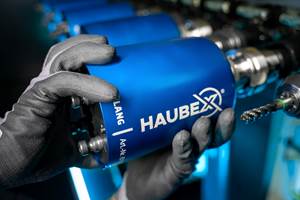Spindle Probes Can Automate Trial Machining
An often-overlooked use for spindle probes is in trial machining applications. These applications are useful when a setup person is worried that the cutting tool might not machine a tight-tolerance workpiece attribute correctly on the first try. In this case, an adjustment will be made (commonly using an offset) to ensure that excess material will be left on the attribute.
Share




The cutting tool will then machine the attribute using the trial machining adjustment. When the cutting tool is finished, the setup person or operator will stop the machine and measure the attribute. They will readjust based on the deviation between the measured attribute’s size and its target. When the cutting tool machines again, the attribute should be at its target dimension.
Consider the manual intervention involved in trial machining. In every step, the setup person (or operator, if dull tools are replaced during the production run) must be available to do something. For entry-level people, the procedure is somewhat error prone. Additionally, there are measurements that are difficult or impossible for the operator to take while the workpiece is in the machine.
In past columns, I have discussed improving the process of trial machining by programming the trial machining operation. If a setup person or operator can recognize the need for trial machining, surely a programmer should be able to as well. A series of slash codes (block delete function) can be included at the beginning of all trial machining commands. In normal production, the block delete switch will be left on, and trial machining will not be done. However, during setup and after dull tool replacement, the setup person or operator will turn off the block delete switch for trial machining.
These techniques facilitate the trial machining process, but they do not automate it. A person must be available to take the measurement. However, a spindle probe will complete the loop, providing a way to automatically measure the workpiece attribute in question.
For the setup person or operator to decide whether to trial machine, they must be available to turn off the block delete switch. For fully unattended operation, some kind of logic must be built into the program. This logic should determine when trial machining must be done when running the cutting tool for the first time and when dull tools are replaced.
While I don’t provide a complete example, I do provide a bulleted list of the most important considerations for automating this process. In the main program:
The trial machining program (O1000 in our case) must:
- Modify the current offset to ensure that excess stock will be left after machining for the first time. This can be done with a G10 command: G91 G10 P5 L11 R0.020 (this command increases offset 5 by 0.020)
- Perform the trial machining operation. Machining will probably be identical to what the cutting tool will do to machine the workpiece attribute, but it doesn’t have to be. Often, just enough machining to take a measurement is all that is required.
- Measure the machined surface. A tool change will be made to call up the spindle probe. Using the probe manufacturer’s pre-written programs or your own, have the probe measure the workpiece attribute. Most probe manufacturers will place the measured value in a common variable, such as #121.
- Calculate the deviation from the target value. The target value can be specified in the main program’s G65 command.
- Readjust the offset. Based on the calculated deviation, use G10 to modify the current offset value.
- Recall the cutting tool and bring it to its previous position in the main program (line N320 in our example). At the beginning of the measuring program (O1000 in our example), you can use system variables #5001, #5002 and #5003 to store the current absolute position of the machine so that the cutting tool can be brought back to its initial position at this point.
Related Content
Same Headcount, Double the Sales: Successful Job Shop Automation
Doubling sales requires more than just robots. Pro Products’ staff works in tandem with robots, performing inspection and other value-added activities.
Read MoreUsing the Toolchanger to Automate Production
Taking advantage of a feature that’s already on the machine tool, Lang’s Haubex system uses the toolchanger to move and store parts, making it an easy-to-use and cost-effective automation solution.
Read MoreLean Approach to Automated Machine Tending Delivers Quicker Paths to Success
Almost any shop can automate at least some of its production, even in low-volume, high-mix applications. The key to getting started is finding the simplest solutions that fit your requirements. It helps to work with an automation partner that understands your needs.
Read MoreCutting Part Programming Times Through AI
CAM Assist cuts repetition from part programming — early users say it cuts tribal knowledge and could be a useful tool for training new programmers.
Read MoreRead Next
Setting Up the Building Blocks for a Digital Factory
Woodward Inc. spent over a year developing an API to connect machines to its digital factory. Caron Engineering’s MiConnect has cut most of this process while also granting the shop greater access to machine information.
Read MoreBuilding Out a Foundation for Student Machinists
Autodesk and Haas have teamed up to produce an introductory course for students that covers the basics of CAD, CAM and CNC while providing them with a portfolio part.
Read More5 Rules of Thumb for Buying CNC Machine Tools
Use these tips to carefully plan your machine tool purchases and to avoid regretting your decision later.
Read More


































